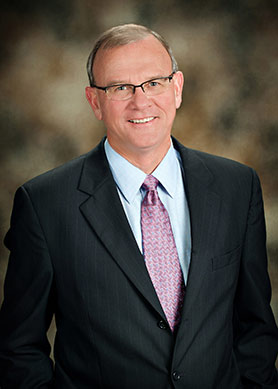2015 CEOs Who "Get It"
The National Safety Council recognizes nine leaders who demonstrate a personal commitment to worker safety and health

 |
 |
Randall A. Neuhaus, PE
President and CEO
S&ME Inc.
 |
Accomplishments
S&ME INC. delivers engineering, design, environmental consulting and construction management services for the built environment. Its purpose is to provide safe, environmentally sensitive sustainable solutions that enrich its communities and improve quality of life. The Raleigh, NC-based company employs 995 workers. |
Why is safety a core value at your organization?
Safety is a core value at S&ME because we have learned that it is fundamentally important in everything we do. We owe our employees the training, tools and support that enable them to safely perform their work. We owe it to our clients to provide trained employees with the proper tools and equipment to complete their projects safely. And finally, we owe it to our employees’ families to do everything in our power to return them home safely each day.
In addition, attention to safety has proved to be a good business decision for S&ME. By actively caring about our co-workers and their families, we have grown a safety culture that not only satisfies clients but also creates a positive work environment that attracts employees.
We are seeing that our safety culture extends into our employees’ home lives. This year we realized a reduction in non-work-related medical claims, which decreases our health insurance premiums. Those savings are shared by the company and our employees.
Describe your journey to becoming a CEO who understands the importance of worker safety. What experiences or lessons brought you to where you are now?
My journey really began in the years prior to my becoming president of S&ME in 2008. S&ME had some unfortunate incidents and, as hard as it is to say, I will say it: We had fatalities. I visited a family to inform the wife of the loss of her husband and looked in the eyes of a 9-year-old boy when he learned his father would never be coming home.
As emotional as this experience was, I don’t think that this moment was when my journey began. My journey started when one of our senior engineers asked me what I was going to do about safety at S&ME when I became president. I don’t even remember what my answer to him was, but I could tell from his expression that he was disappointed in me.
I started thinking about safety and asked this engineer and our corporate safety director what we could do to make S&ME a safer place to work. We hired a safety consultant and I learned a great deal about safety and safety culture, and what effective safety leadership was all about. Leading by example was the first step for me.
I think the real turning point was when one of our safety professionals suggested we initiate a “Distracted Driving Policy.” Prior to implementing the policy, I drove for six months without talking on my cell phone while driving and learned that we can do our jobs without the distraction of cell phones. Implementing this policy was not popular but once we educated employees on the hazards of distracted driving, it was hard for them to argue with us. I have been told by some of S&ME’s senior leadership that this one event sent a strong statement about how serious I am about safety.
My journey has evolved and I try to share our story so that other firms may learn from our experiences. I communicate regularly and strongly to the S&ME staff that my goal is for everyone to arrive home safely every day. I try to lead by example. It isn’t always easy and the journey requires hard decisions from time to time, but the end result is without question worth the effort.
What is the biggest obstacle to safety at your organization, and how do you work to overcome it?
It is easy to talk safety and not so easy to walk the talk. If the leadership of the company is not engaged, how do you expect the troops to follow suit? Tell people what you are going to do and then do it. Have the courage to discipline when discipline is needed and know when to coach when coaching is needed. I have had experiences in which employees broke serious safety rules, and the easy thing would have been to discipline the offenders. Instead, I requested that the offenders come to my office, in some cases a several-hours journey, and have them explain what happened and why they did what they did. My purpose is to listen and learn. It is always a learning experience for me, and I believe my coaching and listening to their concerns go a long way to gaining support.
How do you instill a sense of safety in employees on an ongoing basis?
Instilling safety awareness is an ongoing challenge, and I believe complacency is the enemy. Someone performs a task 100 times without a problem, and then one day without even “thinking” an accident occurs because they didn’t follow procedure. We have the typical safety meetings, tool box meetings, appropriate PPE and a behavior-based safety system in place. We provide a tremendous amount of training. We provide the tools, communicate the goal and instill in employees the confidence to say “No” if there are unsafe conditions. Yet we still have accidents. It has to be more than awareness. It has to be a commitment, and so commitment is what we are focusing on today.
How does your organization measure safety? What are the leading indicators that show you how safe your organization is, and where do you see room for improvement?
Like many firms, we moved from the lagging indicator measurements to the leading indicators. The near-miss reporting, safety meeting attendance, BBS and training are all intended to be leading indicators to prevent accidents. We communicate the safety triangle and try to educate the importance of sharing near misses to help manage risk and create behaviors that prevent more serious injuries. We are not all believers yet. Improvement is when every person is engaged.
What advice would you offer to other leaders whose organizations are at an earlier stage of the journey to safety excellence?
Listen, communicate and lead by example. Everyone is watching you. The leader must have a strong message and a sense of conviction. Sometimes both sides look for scapegoats. Management blames the individual and the individual blames management. People have to understand we are all in this together and you must create a culture of actively caring employees who are committed to performing their job safely and are led by effective leadership. And finally, don’t be afraid to make hard decisions, whether that is setting a policy like distracted driving or taking time to coach employees who made a mistake. Be willing to discipline if necessary for their own well-being and safety.
What advice would you offer to a safety professional whose CEO doesn’t “get it”? How can safety pros secure buy-in from the C-suite?
I think you have to be a teacher. I remember the support, encouragement and, I need to include, patience that I received from my fellow employees at S&ME. Our safety director and the senior engineer I mentioned earlier “got it” long before I did, and I appreciate their advice. I try to listen and learn, and often need to hear it more than once. Demonstrate by example and provide facts. Be a teacher and coach, and your CEO will appreciate your genuine concern for the employees of your firm.
Post a comment to this article
Safety+Health welcomes comments that promote respectful dialogue. Please stay on topic. Comments that contain personal attacks, profanity or abusive language – or those aggressively promoting products or services – will be removed. We reserve the right to determine which comments violate our comment policy. (Anonymous comments are welcome; merely skip the “name” field in the comment box. An email address is required but will not be included with your comment.)

